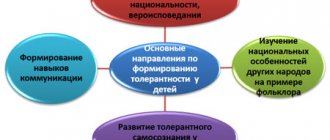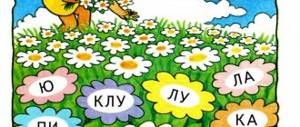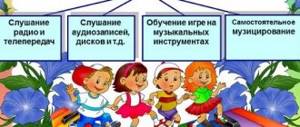Educational event, grades 7-8 on the topic: Tolerance
Summary of educational activities for grades 7 - 8 “Learning to live in a diverse world”
Objectives: 1. Create conditions for the formation of tolerance for differences between people (individual, differences in gender, age, social status, nationality, race, worldview). 2. Overcome and prevent social-emotional problems in students. 3. Help students understand why it is important to respect others. 4. Explain to students why it is very important to be able to solve problems peacefully. 5.Develop speech, enrich students’ vocabulary. 6.Develop the ability to formulate and express one’s opinion, control oneself, and respect other people’s opinions. Objectives: 1. Contribute to the development of active rejection of any form of discrimination. 2. Develop social behavior skills. 3. Develop principles of tolerant behavior Equipment: Multimedia projector, presentation, videos, posters, cards with portraits, tokens, palms, leaves, felt-tip pens, children's drawings. I. Organizational moment 1. Teacher. Hello guys, hello dear adults. - Why are we saying hello? (we expressed respect for each other, which is an integral part of tolerance.) I now propose to greet everyone present: First, you greet like the Japanese (bow) And I suggest the boys greet each other like Europeans (shake hands) Now you greet like Eskimos (rubbing noses) ) And now let’s greet our guests like schoolchildren (they stand up, turn around and say hello) Please sit down. 2. Listening to the song “Children of the Earth.” Teacher: The children of the earth must live in peace and harmony - this is how a very popular song begins optimistically and life-affirmingly. But this is how it is sung in the song, but in life it is much more complicated. It is not so easy to be united by one “ensemble” of relationships, entering such social formations as “country”, “family”, “school”, “class”. Unfortunately, the spirit of intolerance, hostility towards another culture, way of life, beliefs, habits has always existed in society and continues to exist in our time. School is no exception. The subject of intolerance at school can be a person’s national, social, or gender identity, as well as the characteristics of his appearance, interests, hobbies, and habits. In schools and classrooms, the problem of interpersonal relationships is very often encountered, which are often based on the phenomena of intolerance. Living in peace and harmony presupposes that everyone has such human qualities as mutual understanding, mutual respect, responsibility, restraint, compliance, tolerance... II. Setting goals and objectives. 1. Exercise “Walnut”. Teacher. Look at each other. Are there at least two of you similar to each other? What would happen if all people were similar to each other and were no different? Is it interesting to live in such a world of identical people? People complement each other with their distinctive features. To carry out this exercise, you need a bag of walnuts (nuts according to the number of participants). The leader pours nuts in the center of the circle and asks everyone to take one for themselves. For some time, participants are asked to carefully examine their nut, study its structure, structural features, and try to remember all its individual features. Then the nuts are put back into the bag, mixed and poured out again in the center of the circle. The task of each participant is to find his own nut. As a rule, you recognize yours at first sight. After all the nuts have found their owners, the presenter begins the discussion. — It’s interesting to know who remembered their nut and what strategy they used to find it later (remembered its features or simply waited until everyone sorted out their nuts, and at the end the right one remained). - At first glance, it seems that all the nuts are very similar, but if you take the time to look closely, you will notice that they are very different and it is almost impossible to confuse your nut with others. So it is with people: they are all very different, memorable, each with their own individual features, “irregularities,” their own beauty and attractiveness. You just need to feel and understand it. Today we will learn what the word “tolerance” means, we will learn what it means to be tolerant. III. Familiarization with new material. 1. Teacher. Listen to the poem “World Round Dance” by S.Ya.Marshak (accompanied by a video sequence) 1 student Poems for children of All peoples and countries: For the Abyssinians And the English, For Spanish children And for Russian, Swedish, Turkish, German, French Negroes, whose homeland is Africa shore; 2 student For the redskins of both Americas. For the yellow-skinned people, Who need to get up when we go to bed, For the Eskimos, Who in the cold and snow Climb into a fur bag for the night; For children From tropical countries, Where there are countless monkeys in the trees; 3 student For children Dressed and naked - Those who live In cities and villages... Let all this noisy, playful people gather in one round dance. Let the North of the planet meet the South, the West meet the East, and the children meet each other! Teacher. – What is this poem about? (That children of all skin colors should be friends with each other) -Why should all children, regardless of nationality and skin color, live together? (So that there is no war on Earth and everyone lives happily) - Let’s make the first “discovery”: what is tolerance? 2. Presentation by experts. Teacher. -I invited school graduates to our lesson. The girls have already studied social studies and history, and will help you figure it out. History of the concept of tolerance. 1. Not everyone may be familiar with the word tolerance, and at first glance, it sounds completely incomprehensible. But the meaning it carries is very important for the existence and development of human society. The concept of tolerance has its own history. At the turn of the 18th–19th centuries, a certain Talleyrand Périgord lived in France. He was distinguished by the fact that under different governments he remained invariably the Minister of Foreign Affairs. He was a talented person in many areas, but, most of all, in the ability to take into account the moods of others, treat them with respect and at the same time maintain his own principles, strive to manage the situation, and not blindly obey circumstances. The concept of “tolerance” is associated with the name of this person. It is quite difficult to define tolerance due to the fact that it is interpreted differently in different languages. And now we will be convinced of this. Tolerance is the ability to accept ideas or opinions that are different from one's own. (Spanish). Tolerance is an attitude that accepts that others may think or act differently than you do. (French) Tolerance is the willingness to be tolerant, forgiving. (English) Tolerance - allowing, accepting, being generous towards others. (Chinese) Tolerance - forgiveness, forbearance, gentleness, mercy, compassion, benevolence, patience, goodwill towards others. (Arabic) Now listen to the definition of tolerance given in the “Declaration of Principles of Tolerance” (signed on November 16, 1995 in Paris by 185 UNESCO states, including Russia). Tolerance means “respect, acceptance and proper understanding of the rich diversity of our world’s cultures, our forms of self-expression and ways of expressing human individuality. It is promoted by knowledge, openness, communication and freedom of thought, conscience and belief. This is not only a moral duty, but also a political and legal necessity. Tolerance is a virtue that makes peace possible and helps replace the culture of war with a culture of peace.” -What do these definitions have in common? Children: The ability to live in peace and harmony with the whole world. 2. The term “tolerance” comes from Lat. tolerantia - patience. However, it would be wrong to translate the word “tolerance” into Russian as tolerance, since such a translation would be more likely to be associated with submission than with understanding and acceptance. In other words: Tolerance is the ability and willingness to treat others (groups of people) and their behavior with respect, understanding, and tolerance. Tolerance is the recognition of the right of every person to be different. A tolerant attitude is a respectful attitude, an attitude with understanding, with patience. Synonyms for the concept of tolerance include: solidarity, mutual understanding, respect for rights and freedoms, openness, recognition, non-imposition of views, preservation of individuality, provision of development opportunities, ensuring equal treatment, consent, the right to be different from each other, open dialogue, equality in dignity, respect for identity, legal and social protection, sensitivity, responsibility, conflict prevention and resolution through non-violent methods, promotion of professional growth and integration, etc. Intolerant (non-tolerant) – intolerant, disrespectful, hostile attitude). At the heart of intolerance is the belief that your group, your belief system, your way of life is superior, better than others. It denies the right to exist to those who hold different views, prefers suppression rather than persuasion. The forms of intolerance are varied: insults, ignorance, desecration of religious or cultural symbols, threats, intimidation, harassment, enemy-seeking, discrimination, racism. The concept of tolerance has many faces.
Address to the class: We have figured out what tolerance is, let’s now try to define this concept ourselves.
(students offer their options) There are a number of social indicators that psychologists identify, and by the presence or absence of which we can assess the situation in society. Flowchart “tolerance” is placed on the board Flowchart “tolerance” Teacher. Thank you so much guys. I ask you to sit down and participate in our lesson. 3. Speech by the propaganda team. Teacher. To better understand the new concept, I suggest listening to the guys. 1 student Always be tolerant! Put away your hatred. And humanity forever, secure it in the world. 2 student Control yourself, Listen to your loved ones. In the world we live as a family, There are no low actions! 3 student Trust your friends! Be tolerant and polite! Don't shout about trifles! Don't roll the snowball! 4 student Whoever leaves a friend in trouble, He himself will know the bitterness of troubles, And there will be a blizzard in the heart, If there is no friendship in the heart! 1 student - Tolerance is mercy. Student 2 - Tolerance is compassion. 3 student - Tolerance is respect. 4 student - Tolerance is the kindness of the soul. 1 student - Tolerance is patience. Student 2 - Tolerance is friendship. 3 student - Tolerance is forgiveness 4 student - Tolerance is accepting another as he is. They raise posters. 4. Watch a cartoon about tolerance. — What is this cartoon about? What does it teach us? 5. Conducting the test. Test “Are you tolerant?” Teacher. The people who surround us are all different: there are small and large, thin and plump, of different nationalities, with and without glasses. Why do we sometimes laugh at them? Why is it difficult to restrain ourselves when we see the shortcomings of others? However, all people have the right to live with dignity on the planet and not suffer contempt and insults. After all, each of us is unique and significant. How can we become tolerant? First of all, you need to remain yourself, see your mistakes. To be tolerant means to respect others regardless of differences. This means being considerate of others and paying attention to what brings us together. Tolerance allows us to leave more room in our hearts for our friends. Let's try to test ourselves how tolerant we are. We will need red and black mugs. You choose the answer that is closest to you and take the circle of the corresponding color. Presentation 1. Sasha is poorly dressed... It doesn’t matter. You laugh at him. 2. An elderly woman walks slowly. You push her to overtake her. You help her and hold door 3. Someone is being attacked before your eyes... You are trying to protect him. You pretend you don't notice anything. 4. Jack’s skin color is different from yours... You are trying to get to know him better. You say: “All people of your skin color are zeros.” 5. You are a boy, they put you next to a girl... You say that all girls are zeros. You are talking to her. 6. You are a girl, they put you next to a boy... You say that all boys are zeros. You are talking to him. 7. A disabled child approaches you... You naturally talk to him. You walk away from him and don't know what to say. Count the red circles. If you have 6 circles, you show greater tolerance. Wonderful! You are confident in yourself and can express your opinion. And you realized that your freedom ends where the freedom of others begins. If there are from 2 to 5 circles, you are not very tolerant. You are not confident enough to share and express your opinions, however, you are kind and in time you will succeed. You have less than 2 circles: ah-ah-ah! You are not tolerant at all! If you try to better understand yourself as you are, you could be happier! 6. Associative bush “Glade of Tolerance”. Teacher: Every person should grow a tree as a sign of gratitude to Mother Nature. Let us also grow a tree, not just a simple tree, but a magical one - the tree of Tolerance. To do this, we will do creative work. Let our tree put out its leaves and turn green. We will make up the crown of the tree from leaves with your statements on the topic: “The main qualities of a tolerant person.” Take each piece of paper and write on them the character qualities that, in your opinion, characterize a tolerant person. Then glue the leaves onto the tree. Teacher: So, a tolerant person has the following qualities... Children call: Kindness, tolerance, respect, compassion, forgiveness, mercy, peacefulness, cordiality, the desire to do something together, generosity, cooperation, respect for the rights of others, equality, acceptance of others as such, what he is. 7. Solving problem situations. Teacher: Think about it, do we all have the qualities of a tolerant personality? Children: No, we quarrel often... Teacher: Why do conflicts flare up? Children: Inability to get what you want or need; different points of view on the same issue. Teacher: Is it possible to live peacefully and not quarrel? How to do it? Children: YES, you need to show respect to your classmates. Treats all people the way we treat ourselves. Teacher: I present you with a problematic situation. You are playing with a toy or a game, and someone comes and takes it away without even asking whether you are finished playing or not. -What will you do in this situation? -What can be done to maintain calm in a conflict situation? Children: Discuss the problem and go their separate ways, change the topic, postpone the discussion until both have calmed down. Teacher: I want to offer you a reminder that will teach you how to behave correctly in a conflict situation. Reminder: Stay calm when you're angry. Control yourself, have restraint and composure. Have the patience to listen to your interlocutor. Calmly explain your point of view. Think about why the dispute arose. 8. Game "Airplane". Teacher. Resolving conflicts is not easy. What is needed for this, the game will show. A pair of participants take each other's hands and make a paper airplane with their free hands. Teacher. What did the children do to make the airplane work? Conclusion: You tried to come to an agreement with each other, distribute who will do what and complete the task together. Remember: you can always reach an agreement with each other. 9. Game “Magic Hand” (technique of searching for a tolerant position). Teacher. We tried to find out what qualities a tolerant person should have. What qualities do you have? I propose to circle your hand on a piece of paper and write on your fingers your good qualities, and on your palm - what you would like to change in yourself. We hang it on whatman paper. Teacher. I am very glad that all your fingers are filled with positive qualities, and we will work on your palms in the future. V. Consolidation. Teacher: Alienation and hostility in the perception of another culture is a very common phenomenon in our lives. It arises from fear of the unknown, anticipation of hostility from another group. Feelings of discomfort from the invasion of “strangers” into normal life. If you get to know each other better, accept others as they are, and be more tolerant, such problems will not arise. It often happens that you are faced with misunderstanding, both from adults and from peers. This happens because different people perceive us differently. Life is a theater. Everyone has their own roles in life - student, son or daughter, grandson, friend, neighbor, classmate, passenger, pedestrian, etc. The ability to understand and get to know other people is a feature of tolerant behavior. A tolerant person can find a kind, encouraging word for every person. 1. Game “And I think so...” Teacher: - I suggest working in groups. I will give each group a portrait. Your task is to choose as many words as possible to describe the person. Only the first group looks for positive traits, and the second - negative ones. Afterwards, one of the group will offer us the result of your work. Discuss for 2 minutes. Captains report. Teacher. I show identical portraits. Why were the characteristics different? Conclusion: You can see both good and bad in every person. We don't like everything about people. Sometimes the behavior, habits, reactions to something of other people throw us off balance, and sometimes even irritate us. But we must learn to be tolerant of others, respect the individuality of each person around us. 6. Summing up. Teacher: Do we know each other well? Sometimes, for a long time communicating with each other, spending a lot of time at school, we do not know a person for real. Let's look at the attitude towards each other carefully. It is nice when you are surrounded by attentive and caring people, when you say good words, but “to believe in good, you have to start doing it”, let's try to make our world even a bit better and kinder. 1. The “glomerulus” teacher takes the ball in his hands. Teacher: When passing this ball, tell your classmate “I like you because ...” or “I liked how you ...”. The teacher pronounces the phrase first, then the ball is transmitted to the next, but the beginning of the thread remains in the hands of the teacher. In the end, passing through the hands of all participants, the ball returns to the teacher, the thread closes. Teacher: We got the territory of tolerance. Is it nice for you to say kind words to other people? And hear pleasant words about yourself? In this multi -colored world, we are all connected by one thread, most often it remains invisible, but how strong this thread will depend on each person. It is always important to remember this. Anger, distrust, hatred can easily break this thread (on these words you can cut the thread between 2-3 students) and then the person is left alone with his joys and troubles. It is important to feel, understand other people, to be more tolerant of other people's mistakes and disadvantages. And today we want to finish our conversation by the appeal of Vasily Alexandrovich Sukhomlinsky. Let these words be a parting words, advice in your future life. “Know how to feel a person next to you, know how to understand his soul, see in his eyes a complex spiritual world - joy, grief, trouble, misfortune. Think and feel how your actions can affect another person’s spiritual state. ” A person cannot live alone. So conceived by nature. It is in the Commonwealth with others that we create our present. We are different - this is our wealth. We are together - this is our power sounds the song “Let love runs the world” performed by F. Kirkorov
We recommend watching:
Methodological development of a class hour for 8th grade on the topic: Healthy lifestyle Extra-curricular activity at school “Fashionable school sentence” Extra-curricular activity “Beer: myths and reality.” Notes for high school students An extracurricular activity for students in grades 7-10. Flower Symphony
Similar articles:
Event “Day of Slavic Literature” at school, grades 8-9
Tolerance project “We are so different”
Bibliographic description:
Starakorova, I. N. Project on tolerance “We are so different” / I. N. Starakorova. — Text: direct // Questions of preschool pedagogy. — 2020. — No. 3 (6). — P. 69-71. — URL: https://moluch.ru/th/1/archive/41/1239/ (access date: 10.10.2020).
A person with a huge reserve of patience and tolerance goes through life with a special degree of calm and tranquility. Such a person is not only happy and emotionally balanced, but he is also healthier and less susceptible to illness. He has a strong will, a good appetite, and it is easier for him to fall asleep, because his conscience is clear.
Dalai Lama XIV
Project abstract
The goal of this project is to develop and strengthen tolerant relationships among children of senior preschool age with representatives of different cultures and nationalities through familiarization with the cultural traditions of the peoples of Russia.
Project objectives:
- To develop and implement into the practice of preschool educational institutions a plan-project for the formation of tolerant relationships among children of senior preschool age.
- Teach children the rules of the games of the peoples of Russia and the ability to use them in independent activities.
- To develop in children the skills of adequate, respectful and friendly behavior when interacting with representatives of different cultures.
- To instill in children interest and respect for the traditions of other national cultures, by introducing children to the art of the peoples of Russia.
The project will allow organizing practical work on tolerant education of children of senior preschool age and developing a system of activities with parents and teachers of preschool educational institutions in this direction; the environment will be enriched and replenished, facilitating the development of skills of a tolerant attitude towards representatives of different nationalities and cultures.
Justification of the need for the project
Science has formulated the conceptual foundations of the concept of interethnic tolerance; The features of its manifestation in preschool age are analyzed. Tolerance is a personal or social characteristic that presupposes the awareness that the world and the social environment are multidimensional and, therefore, views on this world are different and cannot and should not be reduced to uniformity or in someone’s favor.
In relation to children of senior preschool age, interethnic tolerance is considered as an integrative personality quality that determines the child’s desire and ability to carry out social communications on the basis of a tactful and respectful attitude towards people around him, regardless of nationality.
Interethnic education is a process of purposeful interaction between a teacher and children with the aim of introducing them to the rich cultural heritage accumulated by humanity, forming friendly relationships, positive interethnic communication, showing friendliness and sympathy for one’s own and other peoples, tolerance and delicacy towards them.
Tolerance, being an integrative personal formation, does not arise out of nowhere and is not innate. Tolerance is subject to development, stimulation and correction. Preschool age is a period when initial moral values and norms of behavior are formed, ideas about the importance of human dignity are formed, an understanding of the value of one’s own personality and other people is developed, respect for them, tolerance, a sense of solidarity and the desire for cooperation, and the ability to non-violently resolve conflict situations are developed. . Thanks to the plasticity of the nervous system, openness and influence of an adult, a child in preschool age intensively acquires various knowledge about the world, skills and abilities of its cognition, begins to actively assimilate the values of society, and become familiar with social roles (Sh. Amonashvili, L. S. Vygotsky, A. V. Zaporozhets, N. N. Poddyakov, etc.). Thus, this is the most favorable time for developing in a child interest and respect for his native culture, accepting the diversity and specificity of other cultures, and cultivating a friendly attitude towards people, regardless of their nationality.
Interethnic education, starting from preschool age, should help ensure that, on the one hand, the child understands his roots and thereby can determine the place he occupies in the world, and on the other, instill in him respect for other cultures.
Having analyzed all of the above information, we came to the conclusion that it is necessary to develop an innovative project that is focused on developing tolerant relations among children of senior preschool age through familiarization with the cultural values of different peoples.
Developed specially organized events make it possible to strengthen partnerships and enrich children with knowledge of the cultural traditions of different peoples (games, songs, dances, holidays, etc.). The project can be used in various activities of teachers and specialists in preschool institutions.
Long-term work plan for the project
| Stages of work | Events |
| Research stage | Parent survey “Developing a culture of tolerance in your child” |
| Diagnosis of the formation of a tolerant attitude towards reality in children of senior preschool age | |
| Diagnosis of the current level of tolerance in a peer group in children 6–7 years old (sociometric study) | |
| Preparatory stage | Analysis of diagnostic test results |
| Consultation for teachers on the topic: “Formation of interethnic harmony and tolerance among preschool children” | |
| Presentation of the project, informing parents about the project | |
| Development of a card index “Outdoor games of different nations” | |
| A selection of musical works from different countries | |
| The main stage is project implementation | Conversation-reasoning on the topic: “Why are traditions needed?” (communication, socialization, cognition) |
| S/r game “Travel in a hot air balloon to visit friends” (acquaintance with the traditions of different peoples) (socialization, cognition, communication) | |
| Creations (cognition, communication) | |
| Drawing as a gift to a friend “Portrait of my friend” | |
| The use of outdoor games of different nations in GCD FISO | |
| Making the album “We are all different” (cognition, communication, socialization, artistic creativity) | |
| Consultation for parents on the topic: “We live as one family” | |
| The main stage is project implementation | Sports and music festival “Friendship Festival” (artistic creativity, socialization, CHL) |
| Meetings in the literary lounge “In the Circle of Friends” (CHL, communication, socialization, artistic creativity, cognition) | |
| Musical entertainment “We will live in a world of friendship” | |
| Entertainment “Country of Tolerance” (communication, socialization, artistic creativity, cognition) | |
| Creating a collage on the theme: “We are different, but we are together” (communication, socialization, cognition, artistic creativity) | |
| Theatrical performance “Nothing is more beautiful than our Motherland” | |
| “Threads of Friendship” reminders for parents and teachers on developing tolerance in preschoolers | |
| The final stage | Final diagnosis of the level of tolerance in a peer group in children 6–7 years old (sociometric study) |
| Diagnosis of the formation of a tolerant attitude towards reality in children of senior preschool age |
Conclusion
Preschool childhood is a time of achievements and problems not only for one little person, but for the whole society as a whole. At this age, children develop the skills of respectful and friendly behavior during relationships with representatives of different cultures, the ability to perceive the environment as the result of cooperation between people of different nationalities and different ethnic origins. They have a positive effect on a person, transform him, elevate him, and return him to a more harmonious state.
Thus, nurturing in the younger generation the need and readiness for constructive interaction with people and groups of people, regardless of their national, social, religious affiliation, views, worldview, styles of thinking and behavior is a necessary condition for the formation of a child’s personality in modern society
Literature:
- Astashova N. A. The problem of teaching tolerance in the system of educational institutions // Tolerant consciousness and the formation of tolerant relations (theory and practice): Collection. scientific method. Art. — 2nd ed., stereotype. - M.:, 2003. - P. 74–85.
- Bondyreva S.K. Tolerance (introduction to the problem) / S.K. Bondyreva, D.V. Kolesov. - M.: Publishing house of the Moscow Psychological and Social Institute; Voronezh: Publishing house NPO "MODEK", 2003. - 240 p.
- Declaration of Principles of Tolerance. Approved by resolution 5.61 of the UNESCO General Conference of November 16, 1995 // Century of Tolerance: scientific and journalistic bulletin. - M.: MSU, 2001.
Key terms
(automatically generated)
: senior preschool age, artistic creativity, preschool age, child, communication, cognition, tolerant attitude, friendly behavior, interethnic tolerance, interethnic education.







